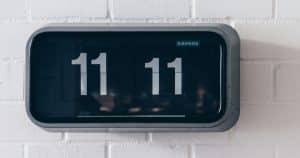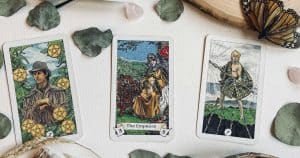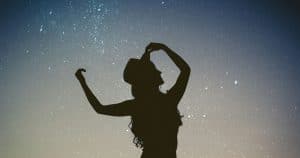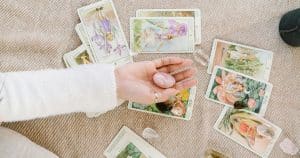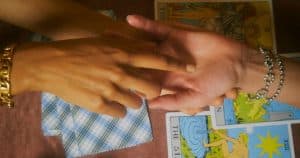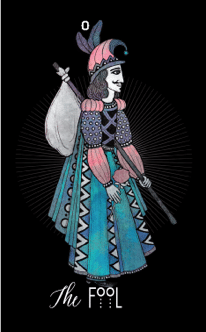
In today’s world of computers, machines, and modern science, there is very little room for anything supernatural or occult. Many people have come to believe that our lives and experiences should be led by science alone, and we completely forget what methods people used far before Newton ever created his laws. This is not to say, of course, that science is useless, in fact quite the contrary. But we forget that we are not purely skin, bone, and muscle – we all contain some spiritual element, something science and nature cannot explain. Tarot is one of many methods we can use to help understand ourselves at a deeper level, a level that science cannot even begin to penetrate.
Many people have misconceptions of Tarot. They may think it is evil, demonic, or related to witchcraft. For some it may conjure images of gypsies, old hags or Creole shamans. These images are related to Tarot’s past, but they actually have nothing to do with Tarot itself. The Tarot is believed to have been first used in Italy in the 1300s. It started out not as a form of divination, but for use in simple card games, an early version of our modern 52-card deck. The Tarot is classified into the following categories: The first 22 Major Arcana Tarot cards are known as The Fool’s Journey, describing the big moments in our lives from birth to death. The rest of the cards are divided into four suits according to the four elements. The Minor Arcana describe the small, specific stories of life, and each of the four suits is numbered one through ten. The four suits are Swords, Cups, Wands, and Pentacles. There are also 16 Court cards that represent the people and personalities of the Tarot, consisting of Kings, Queens, Knights, and Pages in all four suits.
Tarot did not become a part of Western culture until the late 1700s and early 1800s, when Eliphas Levi, a Catholic priest, writer, and teacher created his own Tarot deck based upon principles from several world religions, astrological symbols and events and the elements in nature (fire, water, air, earth). Levi claimed that the cards were to help his students in the art of spiritual enlightenment, self-awareness and self-improvement. In the 1800s A. E. Waite realized that the cards could be used to predict future events and published in 1896 his own Rider-Waite deck based on Eliphas Levi’s works, which is still the most widely used deck today. In this way the Tarot was introduced into Western culture, reaching its height of popularity during the First World War.
The Tarot may seem completely different from every other supernatural / metaphysical activity or belief system, but it, along with many other metaphysical resources, is based on the same few principles. One of these principles is the four elements: fire, water, earth, and air. The zodiac and other astrological symbols are based on the four elements; in fact one can see that the signs of the zodiac are divided this way. Water signs are Cancer, Scorpio, and Pisces; the Fire signs are Aries, Leo, and Sagittarius; the Earth signs are Capricorn, Taurus, and Virgo; and the Air signs are Aquarius, Libra, and Gemini.
The Tarot, likewise, is based on these same four elements, as indicated in its suits. The suit of Cups pertains to relationships, love, feelings, emotional issues, and psychic concerns, which corresponds with the element of Water. The suit of Pentacles relates to the material world, health and finances, which corresponds to the element of Earth. The suit of Wands pertains to passion, action, inspiration, and creativity, which relates to the element of Fire. Lastly, the suit of Swords relates to communication and mental/intellectual action, which corresponds with the element of Air. In this way, the signs of the zodiac and the suits of the Tarot are intertwined and formed from a common base.
As the suits are related to the four elements, so are the four different types of face cards: The King is Fire, the Queen is Water, the Knight is Air, and the Page is Earth. This makes the King of Wands, the Queen of Cups, the Knight of Swords, and the Page of Pentacles especially strong cards. The Tarot is simply based on the natural elements of the earth, not witchcraft or dark magic, as some may wrongly believe.
Yet just as people are skeptical of astrology, palm readings, and psychics, people are skeptical of the Tarot. They think, “How are a few measly cards going to predict my future or change my life?” It is true that there are hacks and con artists out there, but when Tarot cards are placed in the hands of an experienced and gifted psychic, the results may be shockingly accurate. In one such case, a man took up an offer for a free Tarot reading with a psychic, who told him that he was “heading for some major life changes.” The psychic predicted that he was going to have a new member of the family, and the man thought it was nonsense as he and his wife were not heading in that direction. He dismissed the reading, but a few days later his wife came back from a routine check-up with her doctor and told him she was pregnant. Was it just coincidence or something more? You decide.
But regardless of whether or not you believe that there is any way to predict one’s future, one thing is certain about the Tarot: it is not evil. In the hands of a capable psychic, Tarot cards are, at the least, harmless and fun and, at the most, extremely accurate and very useful. Although you cannot deduce the exact date or time a particular event will happen, the Tarot gives you a good idea of where you’ve been and where you’re going. It is useful for further understanding of yourself and your life, to learn about past and future mistakes and how not to make them again.
The signs of the zodiac and astrology are generally accepted and incorporated into mainstream society, so it is only logical that the Tarot be treated the same way. It is certainly entertaining and sometimes very accurate. So why not get a tarot reading today? Your future is in the cards.



